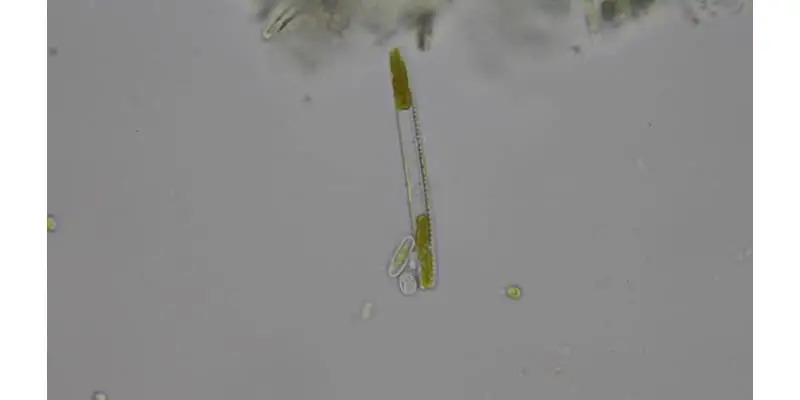If you’re not familiar with Diatoms you may have simply overlooked them while you were observing bigger more mobile microorganisms. However diatoms are extremely important to the environment and interesting in their own right.
Diatoms are a very common type of microscopic algae that dwell in marine habitats as well as in freshwater and topsoil and range in size from 20 to 200 micrometers long. Diatoms are unicellular organisms, like other algae, protozoa, bacteria, and fungi. Unlike bacteria, however, diatoms are eukaryotic organisms, meaning single-celled diatoms contain a nucleus, like plant, animal, and fungal cells.
Diatoms Overview
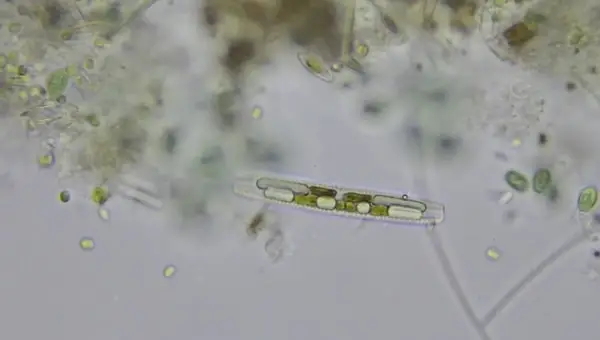
In general, algae are eukaryotic organisms capable of photosynthesis, and diatoms fit this description. Like other algae, diatoms are autotrophs, meaning they can synthesize complex organic compounds necessary for life from carbon dioxide through photosynthesis. In nature, diatoms can be found living individually, living in branched chain filaments, or in larger colonies. Diatoms account for a highly significant proportion of the Earth’s total biomass, or the total mass of all existing biological organisms.
Algal blooms, or large, concentrated amounts of reproducing diatoms, reflect light differently than ocean waters, and thus appear to be a different green-blue color when viewed from space. Diatoms are considered phytoplankton, a term that describes many photosynthetic algae that produce energy by photosynthesis and comprise the foundation of the ocean’s ecological food web.
Phytoplankton like diatoms provide food energy for organisms from larger zooplankton to small fish to whales. Diatoms are widely recognized by microbe enthusiasts and the general public for their wide range of attractive shapes and glassy appearance under a microscope. They occur in nature as circles, squares, ribbons, fans, zigzags, and stars, among other shapes. Diatoms are known as the “jewels of the sea.”
How Are Diatoms Classified?
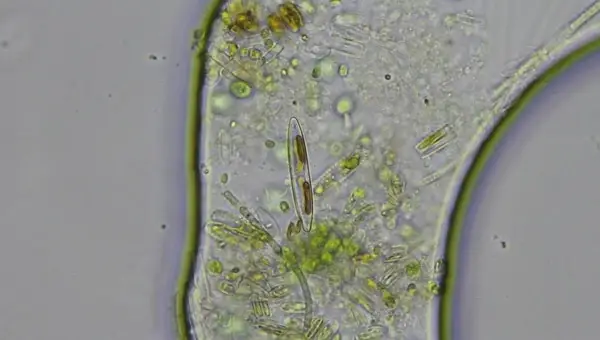
The study of diatoms falls within phycology or algology, the study of algae. Like other common microalgae and phytoplankton, diatoms belong to the Kingdom Protista. Diatom taxonomy, or the biological classification of diatoms in relation to other diatoms and the wider web of life, is complex and evolving. Diatom taxonomy is complicated by the sheer number of known and newly-discovered species of diatoms, which is estimated to be between 12,000 and 200,000 species.
They are considered the most diverse group of protists on Earth. Diatoms are thought to have evolved and come into being during the Triassic Period, and the best fossil records are from the early Jurassic period. This means the total history of diatoms is between 250-190 million years old. Nevertheless, diatoms belong to the Kingdom Protista, the Division (or Phylum) Chrysophyta, and the Class Bacillariophyceae. There are two Orders of diatoms.
The order Centrales, or Biddulphiales, have radial symmetry, while the order Pennales, or Bacillariales, have bilateral symmetry and a more elongated shape. Within the Centrales and Pennales, further suborders exist based on the physical characteristics of each diatom species. Diatom phylogeny, or the study of the evolutionary relationships between diatom species based on their physical and genetic similarity, is also a complex and evolving field.
Early diatom taxonomy and phylogeny prior to the 1990s has been critiqued for its focus on classifying based on limited physical characteristics of diatoms. Of early diatom taxonomy, one author wrote “History suggests that, in many cases, diatomists might just as well have been classifying scraps of wallpaper as diatoms.”
Nonetheless, genomic technologies, which allow for classification based on precise sequencing of conserved genetic characteristics of individual species, has yielded significant progress compared to older methods. Diatom phylogeny, however, remains poorly understood, and more research is necessary to elucidate which diatoms share a common ancestor, and when certain ancient diatom traits evolved.
What do Diatoms Eat?
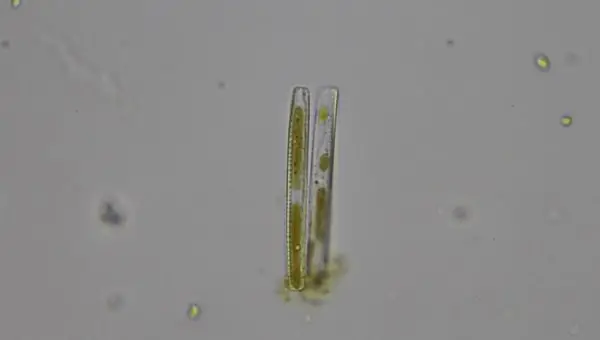
To sustain themselves and produce energy, diatoms require carbon dioxide, water, and light. Like most microorganisms, they are responsive to their environment, and energy production can be influenced by water temperature, light availability, where they exist within the water column, and the speed at which they drift in water. Diatom energy is produced through photosynthesis, wherein energy from sunlight is converted into chemical energy to power a diatom’s cellular processes.
During photosynthesis, molecular oxygen is produced, and diatoms produce approximately 25% of the Earth’s oxygen. The ability of diatoms to undergo photosynthesis makes them similar to plants, but plants and diatoms evolved this ability from separate ancestral lineages. One facet of diatom biology that is truly unique compared to other microorganisms is the diatom cell wall. Diatoms are given their shape and distinct glassy appearance because their cytoplasm is enclosed by an inorganic silica-based cell wall called a frustule.
This glassy frustule requires less energy to create than typical cell membranes, but a significant portion of diatom energy goes toward synthesizing silica polymers inside the cell to build the frustule. In addition, dissolved silica in seawater is used to produce the frustule.
What is the Structure of Diatoms?
Diatoms are composed of cytoplasm enclosed by the aforementioned frustule and range from 2 to 200 micrometers in length. Individual cells are often round, but can be elliptical, square, or triangular. For scale, it is helpful to imagine that diatoms are generally four times thinner than the width of a human hair.
Within the cytoplasm, like other eukaryotic cells, diatoms contain organelles. There is a nucleus, Golgi complex, mitochondria, chloroplasts, and vacuoles that contain oil. Structurally, diatoms are generally made of two valves, which are flat, connected by a girdle band structure. One valve plate, the epitheca, is slightly larger than the other valve plate, called the hypotheca. Diatoms generally drift along with the water that contains them, and do not actively move very far on their own.
However, many diatoms have been observed by scientists to have the ability to glide along a surface, leaving a small trail of mucus behind them. It is known that some diatoms secrete this mucus from a slit in their anatomy called a raphe, but how the process of mucus secretion helps diatoms glide is still poorly understood. It is common for the physical characteristics of the diatom valves and the raphe to vary between different species of diatoms.
The peculiar anatomy and inorganic silica-based cell wall of diatoms affects the organism’s life cycle and method of reproduction. Diatoms are capable of both asexual reproduction and sexual reproduction, depending on the current needs of the cell. The majority of diatom reproduction occurs by asexual binary fission, wherein a cell divides to produce daughter cells. In the case of diatom asexual reproduction, the two daughter cells are normally half the size of the original cell.
Specifically, the two valves of the predecessor cell become each daughter cell’s epitheca, and the daughter cells then synthesize their own hypotheca over time. This process is influenced by the nature of splitting the relatively rigid silicon cell wall. In addition, although diatoms are able to synthesize silica for their cell wall, the availability of nutrient silica in the surrounding water can affect reproduction. Since each daughter cell is half the size of its predecessor, the cells within a diatom population become smaller over time.
The splitting can occur between once and eight times in a day, depending on nutrient availability. Eventually, the cells become too small to sustain life, which is when sexual reproduction occurs. During diatom sexual reproduction, the diatom undergoes a process of cell division called meiosis, which results in male and female gamete sex cells. During sexual reproduction, these gametes fuse to form a zygote, or fertilized cell. This cell grows into a diatom that is the maximum cell size, and the life cycle begins anew.
Where do Diatoms Live?
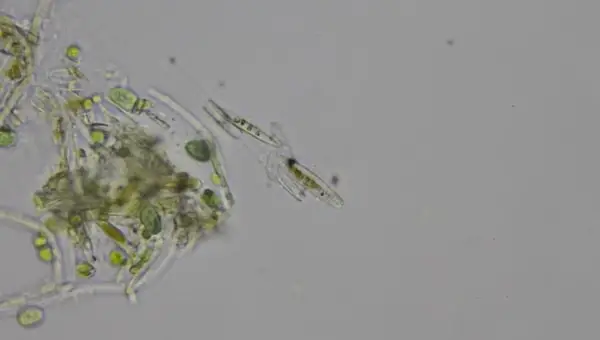
Since diatoms require only water, carbon dioxide, and light to produce energy, they live all over the world in oceans, bodies of freshwater, and damp soils. Free floating diatoms in oceans, called planktonic diatoms, exist in the upper mixed layer of the water column, where there is optimal exposure to nutrients and sunlight. Benthic diatoms, which exist closer to the seabed and are exposed to lower light levels, also exist but are less well-studied than their planktonic counterparts.
Diatoms are considered ecologically competitive, and thus exist in nearly every aquatic environment on earth, specifically marine oceans and seas, freshwater lakes and streams, as well as wetlands and damp soils. Many researchers hypothesize that this ecological success is due to the low energy requirements of the diatoms’ silica cell wall synthesis. Particularly in nutrient-rich coastal marine waters, diatoms quickly outcompete other types of microalgae due to their fast growth rate. This growth cycle leads to an observable growth “bloom,” followed by a period of growth “bust,” when local nutrients are depleted.
In addition, while nutrients deplete during an algal bloom, the rate are which diatoms sink below the upper mixed layer of the water column increases. In addition to increased sinking during the bloom to bust transition, when diatoms die, their frustule shells sink to the bottom of the waterbed and accumulate. Ocean and seabed are full of this diatom shell dust, which becomes white and chalky. On the seabed, this substance can accumulate up to 1,400 meters thick. Commercially, humans known this substance as diatomaceous earth, and use it for a variety of human uses.
Diatomaceous earth is useful to humans as a component in wine and beer filtration, as well as a component of some paints, cat litter, toothpaste, flea powder, and insulation. When scientists examine diatom shells found in this layer of diatom shell dust, they are referred to as diatom fossils and used to draw interpretations about the past. However, these diatoms are not considered truly fossilized, as their hydrated glass shell silica has not been replaced with another mineral.
Are Diatoms Harmful to Humans?
Diatoms are so ubiquitous in nature that they are bound to come into contact with humans. Despite being a crucial part of marine ecology and foundation of the marine food web, as well as the basis for the commercially viable diatomaceous earth, some diatoms are considered harmful to humans.
There is evidence that two diatom genera, Pseudo-nitzschia and Amphora, produce domoic acid. Domoic acid is a neurotoxin that is harmful to humans, mollusks, marine fish, marine birds, and marine mammals. In 1987, there was an outbreak wherein 111 people were poisoned by eating seafood contaminated with domoic acid.
When diatoms, in addition to other domoic acid producing algal species, grow in large quantities in coastal waters, they produce harmful algal blooms referred to commonly as red tides or harmful algal blooms (HABs). Humans swimming or dining near red tides can be in danger of eye and skin irritation consuming toxic fish and shellfish or breathing in toxic air. Human illness as a result of red tide exposure is rare but can result in morbidity and mortality.
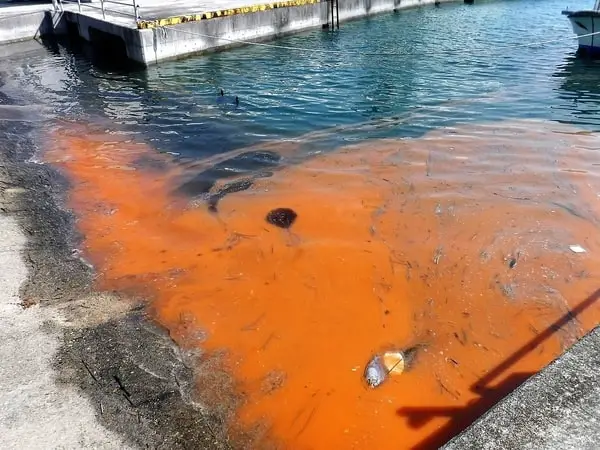
Symptoms of ingesting toxic fish and shellfish include nausea, motor control loss, numb, tingling, or painful extremities, and respiratory paralysis. In addition, harmful algal blooms can result in the temporary closing of commercial fisheries. Some scientists have observed that climate change seems to be exacerbating the appearance of red tides in North American coastal waters. Diatoms are currently used by biologists and ecologists as markers of water quality in some bodies of water.
It is thought that diatoms may be increasingly useful as environmental markers to measure incremental climate change. Additionally, diatoms are of interest to climate change scientists because they consume a significant amount of carbon dioxide during photosynthesis and are crucial to ocean geochemistry as a result.
In a separate issue, aquarium enthusiasts can be bogged down by the appearance or outgrowth of diatoms in home aquariums. Most commonly, a diatom bloom appears in near aquariums and is sometimes referred to as brown algae. The blooms appear as a brown mass of algae a few weeks after the aquarium is set up and can be reduced and prevented by frequent water changes and tank cleanings.
Diatom Discoveries and History
An unknown 18th century scientific observer from England is credited as the first person to discover diatoms. This observation was published by the Royal Society of London. The observer was looking at the roots of a pond weed under a simple microscope, remarking that “”adhering to them (and sometimes separate in the water) many pretty branches, composed of rectangular oblongs and exact squares.” These oblongs and squares were diatoms.
During the 19th century, interest in diatoms surged among early microbe hunters, who competed amongst themselves to describe them. In the late 19th century, diatoms were some of the first cells for which cell division was described and diagramed. During this fruitful period in the history of microscopy, many early 19th century observers produced detailed drawings and schematics of the diatoms they observed under a microscope. Then, in the later 19th century and early 20th century, fossil records of diatoms began to be studied in detail.
Hustedt produced detailed taxonomic references in the early 20th century that is still referenced today. In addition, Round’s diatom reference from the 1990s is considered the most complete taxonomic diatom record. More recently, new discoveries in diatom biology continue to be made. Genomic analyses have shown that diatoms contain a mosaic of genes evolved from plant, animal, and bacterial lineages. Many diatom genes have been acquired from ancient symbiont cyanobacteria, highly prevalent oceanic bacteria.
While it is still not fully understood how diatoms glide by secreting raphe mucus, in the 1990s it was determined that an actin motility system plays a role in this process. In addition, it has been recently shown that oceanic diatoms require less iron to live than coastal diatoms, most likely due to their differences in the cellular machinery necessary to conduct photosynthesis.
Most recently, it was shown that diatom phytoplankton like have their own microbiome consortia, and examples of these can be stably assembled in the laboratory. There is a known interplay between bacteria, which outnumber diatoms by orders of magnitude in the world’s oceans, and diatoms. This involves sharing nutrients and metabolites within an ecological niche. Some current researchers are interested in diatom biology from a bioengineering perspective, hoping that unique facets of diatom biology might be useful in human manufacturing or medicine.
It has been proposed that the oil droplets stored within diatoms may be engineered to produce oil for human use. In addition, it has been proposed that the unique biosilica that comprises diatom cell walls might be engineered for use as a drug delivery vehicle with medical and pharmaceutical applications.
How to Observe Diatoms Under a Microscope?
As diatoms have been observed under a microscope since the early 18th century, solid protocols for diatom microscopy have been established. Diatoms are very common so don’t need to look hard to see them. Colonies, filaments, and flocks of diatoms are commonly viewed and photographed under 100X-400X magnification.
Organic matter in ecological samples may obscure individual diatoms, so an oxidizing agent may be used in preparation to remove this matter. After initial viewing, samples may be further treated, diluted, or dried and mounted on slides for further viewing. If you look closely you may even be able to see other organisms feeding off diatoms!
Takeaways
Diatoms are often referred to as the jewels of the sea because of their symmetric shapes and intricate patterns that resemble jewels. These single celled micro-algae are an important food source for so many other microorganisms in marine life. Diatoms are not the most exciting microorganism to observe but they are ecologically important and deserve our respect.
References
- E. Virginia Armbrust, The life of diatoms in the world’s oceans. Nature 2009.
- Shruti Malviya et. al, Insights into global diatom distribution and diversity in the world’s ocean. PNAS, 2016.
- https://diatoms.org/what-are-diatoms
- https://www.ucl.ac.uk/GeolSci/micropal/diatom.html
- David G. Mann, The species concept in diatoms, Phycologia, 2019.
- David M.Williams, Diatom phylogeny: Fossils, molecules and the extinction of evidence. Comptes Rendus Palevol, 2007.
- S. Sabater, Diatoms. Encyclopedia of Inland Waters, 2009
- Claudia Büchel, How diatoms harvest light, Perspectives. Science 2019.
- Leynaert, A. et. Al, Benthic Diatoms: What Makes Them Unique. American Geophysical Union, Ocean Sciences Meeting 2016
- Erin Main, Diatom populations and environmental factors that may affect their numbers. 2012.
- https://diatoms.org/news/do-diatoms-form-fossils
- Bidhan Chandra Dhar et. Al, Molecular Detection of a Potentially Toxic Diatom Species, Int J Environ Res Public Health, 2015.
- Jenny Howard, Red Tides Explained, National Geographic
- https://www.aquasabi.com/aquascaping-wiki_algae_brown-algae
- https://condor.depaul.edu/diatom/disc2.html

